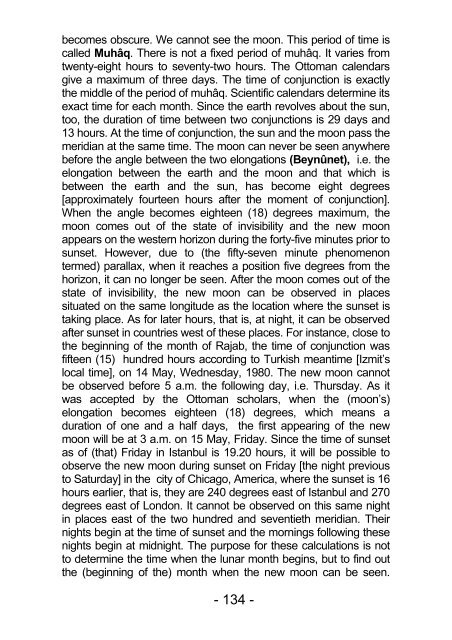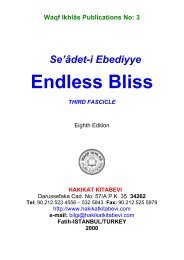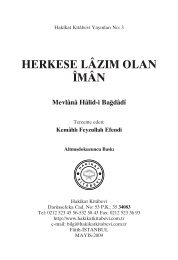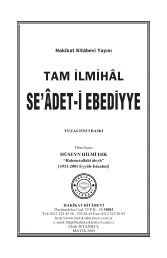5-Endless Bliss Fifth Fascicle - Hakikat Kitabevi
5-Endless Bliss Fifth Fascicle - Hakikat Kitabevi
5-Endless Bliss Fifth Fascicle - Hakikat Kitabevi
You also want an ePaper? Increase the reach of your titles
YUMPU automatically turns print PDFs into web optimized ePapers that Google loves.
ecomes obscure. We cannot see the moon. This period of time is<br />
called Muhâq. There is not a fixed period of muhâq. It varies from<br />
twenty-eight hours to seventy-two hours. The Ottoman calendars<br />
give a maximum of three days. The time of conjunction is exactly<br />
the middle of the period of muhâq. Scientific calendars determine its<br />
exact time for each month. Since the earth revolves about the sun,<br />
too, the duration of time between two conjunctions is 29 days and<br />
13 hours. At the time of conjunction, the sun and the moon pass the<br />
meridian at the same time. The moon can never be seen anywhere<br />
before the angle between the two elongations (Beynûnet), i.e. the<br />
elongation between the earth and the moon and that which is<br />
between the earth and the sun, has become eight degrees<br />
[approximately fourteen hours after the moment of conjunction].<br />
When the angle becomes eighteen (18) degrees maximum, the<br />
moon comes out of the state of invisibility and the new moon<br />
appears on the western horizon during the forty-five minutes prior to<br />
sunset. However, due to (the fifty-seven minute phenomenon<br />
termed) parallax, when it reaches a position five degrees from the<br />
horizon, it can no longer be seen. After the moon comes out of the<br />
state of invisibility, the new moon can be observed in places<br />
situated on the same longitude as the location where the sunset is<br />
taking place. As for later hours, that is, at night, it can be observed<br />
after sunset in countries west of these places. For instance, close to<br />
the beginning of the month of Rajab, the time of conjunction was<br />
fifteen (15) hundred hours according to Turkish meantime [Izmit’s<br />
local time], on 14 May, Wednesday, 1980. The new moon cannot<br />
be observed before 5 a.m. the following day, i.e. Thursday. As it<br />
was accepted by the Ottoman scholars, when the (moon’s)<br />
elongation becomes eighteen (18) degrees, which means a<br />
duration of one and a half days, the first appearing of the new<br />
moon will be at 3 a.m. on 15 May, Friday. Since the time of sunset<br />
as of (that) Friday in Istanbul is 19.20 hours, it will be possible to<br />
observe the new moon during sunset on Friday [the night previous<br />
to Saturday] in the city of Chicago, America, where the sunset is 16<br />
hours earlier, that is, they are 240 degrees east of Istanbul and 270<br />
degrees east of London. It cannot be observed on this same night<br />
in places east of the two hundred and seventieth meridian. Their<br />
nights begin at the time of sunset and the mornings following these<br />
nights begin at midnight. The purpose for these calculations is not<br />
to determine the time when the lunar month begins, but to find out<br />
the (beginning of the) month when the new moon can be seen.<br />
- 134 -











